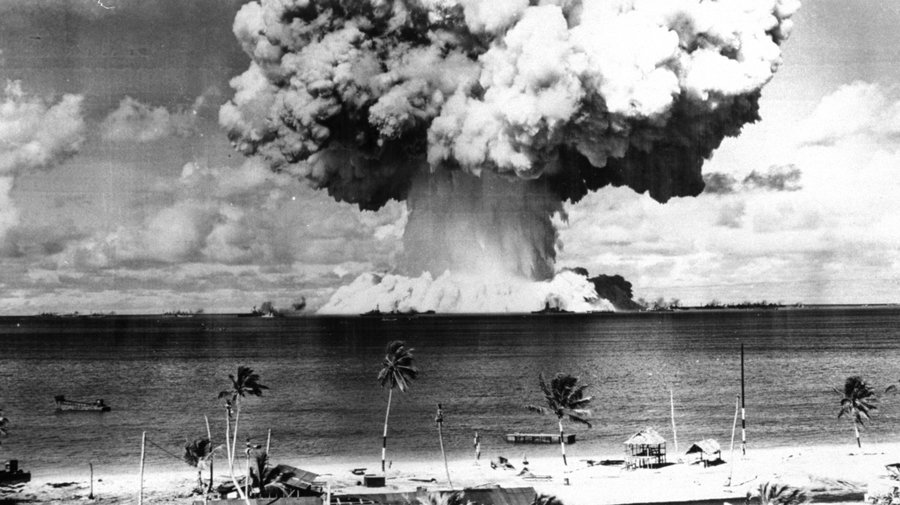“What I do is authorize my military…we have the greatest military in the world…
We have given them total authorization and that’s what they’re doing”
[referencing the decision to drop the “mother of all bombs” on Afghanistan 4/13/17]
—President Trump (4/13/2017)
President Nixon: “Well, no, no…I’d rather use the nuclear bomb”
Henry Kissinger: “That, I think would just be too much.”
President Nixon: “The nuclear bomb? Does that bother you…
President Nixon: “I just want you to think big, Henry…
(White House tapes 4/25/1967)
The perennial tug-of-war between civilian authorities (in the White House) and military commanders (at the Pentagon) has taken on new significance since Donald Trump became president. Six days after his inauguration in January, 2017, the Bulleting of the Atomic Scientists moved the Doomsday Clock forward by 30 seconds to 2½ minutes to midnight. Their decision was influenced by Trump’s “antics” during the campaign and their assessment that his presidency would make the world a more dangerous place. Coupled with the drift of U.S. foreign policy from negotiation to increasingly bellicose rhetoric — the “all options are on the table” meme— we have witnessed an upsurge in the fear of a nuclear holocaust. Apart from historians who make a living delving into every archive as it is declassified, the general public is unaware that almost every president since Hiroshima and Nagasaki has to a greater or lesser extent shifted control and custody of these deadly weapons to the military.
The false narrative that nuclear weapons are securely in the grasp of civilian leaders is taken for granted by the general public with most U.S. presidents taking pains to reinforce that false belief. Even a former military man like Eisenhower realized that the fiction of absolute civilian control over the nuclear arsenal needed to be perpetuated: “It is in the U.S. interest to maintain the atmosphere that all authority [to use nuclear weapons] stays with the US President without delegation.
Despite the propaganda, the military fingerprint (and footprint) is deeply embedded in the development and control of nuclear weapons from the beginning of the nuclear age in 1945. FDR created the ultra-secret Manhattan Project (even vice president Truman didn’t know about it until after FDR’s death), and chose an army general, Lesley Groves, to lead it. Whether FDR meant to cede complete and perpetual control to the military will forever remain a mystery as he died months before the first two were dropped. One thing we do know —his selection of General Lesley Groves, a staunch advocate of military superiority, guaranteed that the struggle over control of nuclear weapons between civilian leadership and the military high command would be ongoing. In 1946, too late for the people in Hiroshima and Nagasaki, President Truman signed the McMahon Atomic Energy Act transferring control of atomic energy from the military to the civilian Atomic Energy Commission.
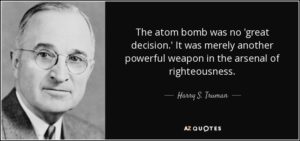 President Truman’s epiphany in 1946, on the need to establish a civilian agency to safeguard the U.S. nuclear stockpile probably had a lot to do with the orchestration of the nuclear attacks on Hiroshima and Nagasaki in 1945. Documents declassified in the nineties suggest that Truman left most of the planning and implementation of the strikes to military commanders. A diary entry he made in late July several weeks before the bombings is a sad commentary on his abdication— “military objectives and targets [were the proper targets of atomic weapons] not women and children. General Groves later revealed what he considered Truman’s proper role in the decision-making “As far as I was concerned, his [Truman’s] decision was one of non-interference —basically a decision not to upset existing plans.”
President Truman’s epiphany in 1946, on the need to establish a civilian agency to safeguard the U.S. nuclear stockpile probably had a lot to do with the orchestration of the nuclear attacks on Hiroshima and Nagasaki in 1945. Documents declassified in the nineties suggest that Truman left most of the planning and implementation of the strikes to military commanders. A diary entry he made in late July several weeks before the bombings is a sad commentary on his abdication— “military objectives and targets [were the proper targets of atomic weapons] not women and children. General Groves later revealed what he considered Truman’s proper role in the decision-making “As far as I was concerned, his [Truman’s] decision was one of non-interference —basically a decision not to upset existing plans.”
On August 10th, one day after the horror in Nagasaki, Truman reasserted civilian control over nuclear weapons by prohibiting future bombings without his explicit permission. Truman wrote to David Lilienthal, first chairman of the Atomic Energy Commission, to explain his decision: “It is a terrible thing to order the use of something that…destructive…this isn’t a military weapon. It is used to wipe out women and children and unarmed people…So we have to treat this thing differently from rifles and cannons.” It should be noted that his sorrow over “wiping out women and children and unarmed people” did not stop him from declaring for the rest of his life: “I was there. I did it. I would do it again.”
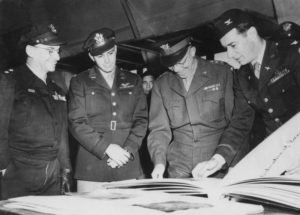 The era of exclusive civilian control of nuclear weapons had a short life — less than a decade. In 1950, General Eisenhower became president. His military background led him to make a phenomenal blunder — the policy known as pre-delegation, which allows a president to extend his authority to order a nuclear attack to another person, civilian or military. Eisenhower believed that high-ranking military commanders needed to be able to authorize nuclear strikes when there was not enough time or it was not possible to communicate with the President. According to several declassified documents, Eisenhower was well aware that such advance authority could allow a military officer, like General Curtis LeMay who once opined “there are many time when it would be most efficient to use nuclear weapons,” to do [as Eisenhower saw it]“something foolish down the chain of command” (as in start a nuclear war). Knowing the ice was pretty thin in pre-delegation land, Eisenhower was “very fearful of having written papers on this matter.” He finally agreed to put the agreement in writing in a top-secret document. Publicly, however, Eisenhower kept his pre-delegation policy secret not only from the American people, but from Congress and U.S. NATO allies as well.
The era of exclusive civilian control of nuclear weapons had a short life — less than a decade. In 1950, General Eisenhower became president. His military background led him to make a phenomenal blunder — the policy known as pre-delegation, which allows a president to extend his authority to order a nuclear attack to another person, civilian or military. Eisenhower believed that high-ranking military commanders needed to be able to authorize nuclear strikes when there was not enough time or it was not possible to communicate with the President. According to several declassified documents, Eisenhower was well aware that such advance authority could allow a military officer, like General Curtis LeMay who once opined “there are many time when it would be most efficient to use nuclear weapons,” to do [as Eisenhower saw it]“something foolish down the chain of command” (as in start a nuclear war). Knowing the ice was pretty thin in pre-delegation land, Eisenhower was “very fearful of having written papers on this matter.” He finally agreed to put the agreement in writing in a top-secret document. Publicly, however, Eisenhower kept his pre-delegation policy secret not only from the American people, but from Congress and U.S. NATO allies as well.
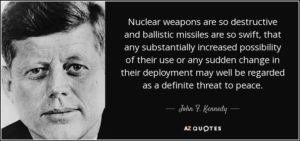 President Kennedy came to office in 1960 promising to bring peace, not make war. Almost immediately he was informed: “A subordinate commander faced with a substantial military action could start a thermonuclear holocaust… if he could not reach you.” Although he found the idea of pre-delegation chilling, JFK decided to let Eisenhower’s pre-delegation instructions stand during the 1961-1962 Berlin crisis and the 1962 Cuban missile crises. Underscoring the danger of military control of nuclear weapons, on October 26,1962, during the Cuban missile crisis, an ICBM was actually launched, not by the Russians but by the US Air Force from a base in California. No evidence has ever surfaced to indicate who authorized the launch.
President Kennedy came to office in 1960 promising to bring peace, not make war. Almost immediately he was informed: “A subordinate commander faced with a substantial military action could start a thermonuclear holocaust… if he could not reach you.” Although he found the idea of pre-delegation chilling, JFK decided to let Eisenhower’s pre-delegation instructions stand during the 1961-1962 Berlin crisis and the 1962 Cuban missile crises. Underscoring the danger of military control of nuclear weapons, on October 26,1962, during the Cuban missile crisis, an ICBM was actually launched, not by the Russians but by the US Air Force from a base in California. No evidence has ever surfaced to indicate who authorized the launch.
Later, JFK attempted to regain control of nuclear weapons by ordering all nuclear weapons outfitted with “permissive action links” (PALs), which would require the use of a code (known only to the president) to activate. The Joint Chiefs resisted declaring that “All is well in the atomic stockpile program, there is no need for any change.” JFK was unable (or unwilling) to withstand the pressure from the Pentagon and “compromised” by applying the new rules only to NATO nukes (10% of the stockpile).
Who had supreme control over nuclear weapons during LBJ’s administration is still classified. We do know that both the Joint Chiefs and former President Eisenhower recommended using nuclear weapons in North and South Vietnam and at the China border during the Vietnam War. LBJ resisted their advice.
His successor, Richard Nixon, was determined to use the threat of nuclear war to his advantage (his madman strategy)— going so far as to authorize a bizarre, top secret global military exercise designed to look like a nuclear alert. “The Joint Chiefs of Staff Readiness Test” as it was called was a Nixonian scheme to scare Ho Chi Minh into making concessions at the bargaining table. Ho was unimpressed.
Although pre-delegation since the sixties has been shrouded in mystery, many experts, among them Bruce Blair, a respected nuclear security expert, believe that pre-delegation remained alive and well into the late eighties. Other experts noting that most of the documents on pre-delegation from the sixties to the present remain classified are concerned that pre-delegation has never been formally eliminated.
Where does that leave the American people in 2018? Whether or not pre-delegation is still in force, President Trump has made it clear that the Pentagon calls the shots when it comes to the conduct of seven post-911 wars the U.S. is involved in and the performance of Special Operations Forces all across the globe. Are nuclear weapons part of the president’s surrender? We don’t know and aren’t likely to find out until it’s too late. However, the president’s fawning regard for all things military, his pathetic eagerness to pass muster with the generals doesn’t bode well for the safety and security of the US nuclear weapons cache.
It is a rare leader that has not succumbed to the military’s demand for some measure of control over nuclear weapons. With or without military involvement, we have come within a hair of a nuclear holocaust at least three times as well as experiencing a succession of near catastrophic mistakes that might have resulted in an accidental or unauthorized nuclear detonation.
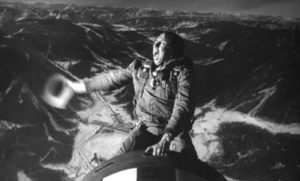 “…Now then, Dmitri [US “president” telephoning “Dmitri,” Russian president] “you know we’ve always talked about the possibility of something going wrong with the bomb…Well now what happened …one of our commanders…went a little funny in the head and he went and did a silly thing…He ordered his planes…to attack your country.” (From the 1964 film Dr. Strangelove or How I Learned to Stop Worrying and Love the Bomb)
“…Now then, Dmitri [US “president” telephoning “Dmitri,” Russian president] “you know we’ve always talked about the possibility of something going wrong with the bomb…Well now what happened …one of our commanders…went a little funny in the head and he went and did a silly thing…He ordered his planes…to attack your country.” (From the 1964 film Dr. Strangelove or How I Learned to Stop Worrying and Love the Bomb)
The sad and ugly truth is that most of today’s military leaders, despite a succession of astonishing failures throughout the last half-century, cling to the fantasy that “…war is too important to be left to the politicians. They have neither the time, the training, nor the inclination for strategic thought.” (General Jack D, Ripper in Dr. Strangelove)
Grab a DVD of Dr. Strangelove from your local library and Be Afraid, Be Very Afraid.
If you liked this article you will like this one too…click here
1,404 total views, 1 views today
